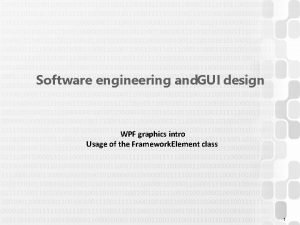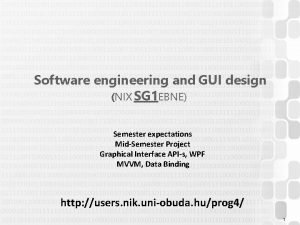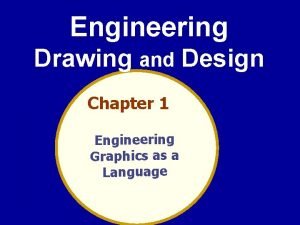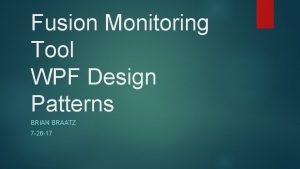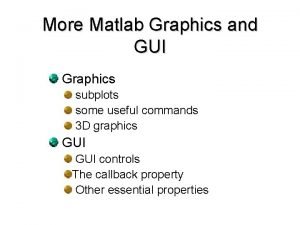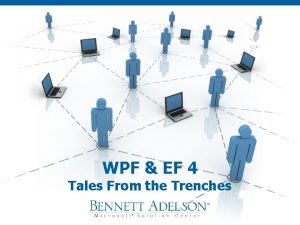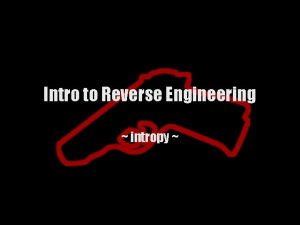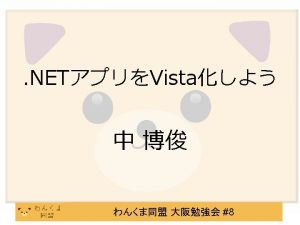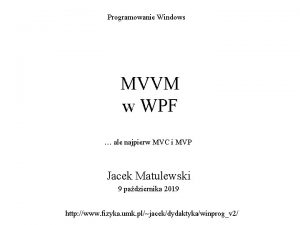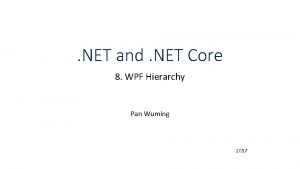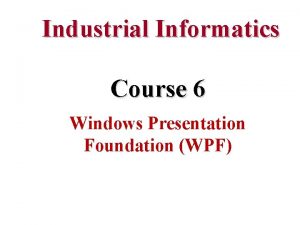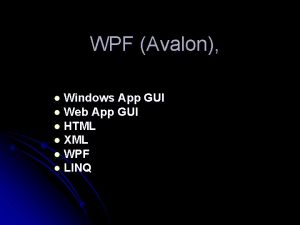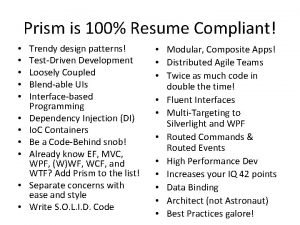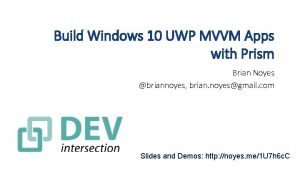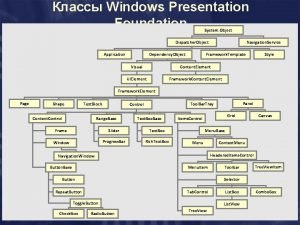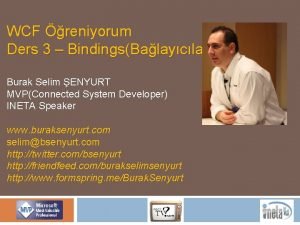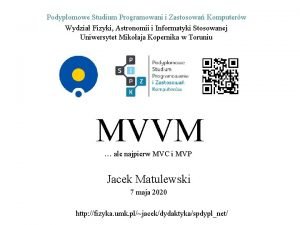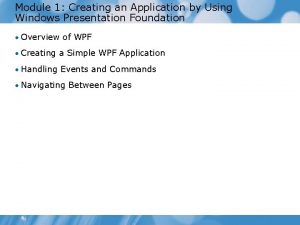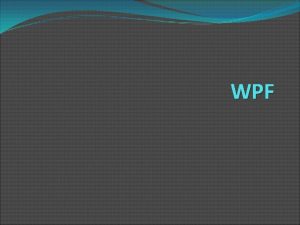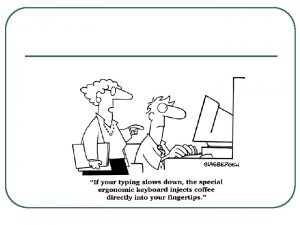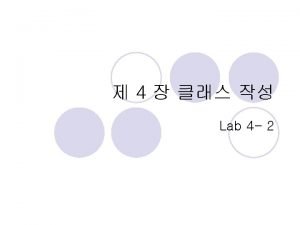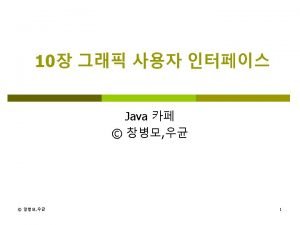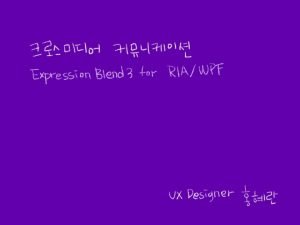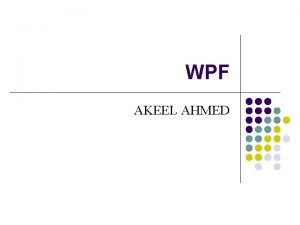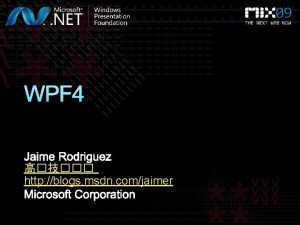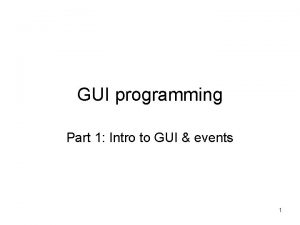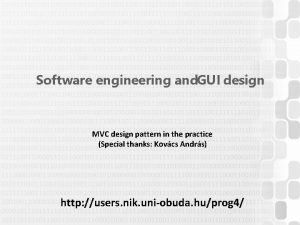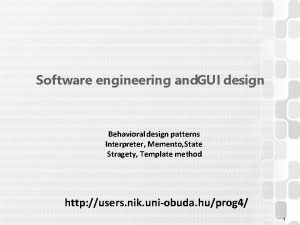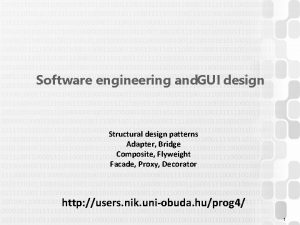Software engineering and GUI design WPF graphics intro








































- Slides: 40

Software engineering and. GUI design WPF graphics intro Usage of the Framework. Element class 1

WPF graphics – coordinate system • The (0, 0) point is in the top-left corner, so every location is the position of the top-left corner based on the top-left corner of the container – An object’s final location is affected by many properties: Horizontal. Alignment, Margin, Padding, layout manager settings, … – Taking all factors into account, there is a separate phase (“Layout”) that determines the final 2 D position – not trivial to read, very hard to write! – Much easier if we use the Canvas layout manager 2

WPF graphics – types (System. Windows) • Nothing is displayed, these types are only used for data representation ! • Struct types (value types) • Point: a single point in 2 D space – X, Y • Size – Width, Height • Rect, Int 32 Rect: a rectangle in 2 D space – X, Y, Width, Height, Top, Bottom, Left, Right • Vector: a location vector in 2 D space – X, Y, Length. Squared 3

WPF graphics – colors • Every color is represented with four 8 bit values: • Red (R), Green (G), Blue (B) – bytes (0 -255), so totally 256^3 ≈ 16 million colors are possible (“good enough”) • Alpha (A) – Defines the transparency of the color, 0: fully transparent, 255: not transparent • The Color struct is used to represent colors Color color = Colors. Red; Color color = Color. From. Argb(20, 255, 0, 0); 4

WPF graphics – brushes • Forrás: http: //i. msdn. microsoft. com/dynimg/IC 107818. jpg 5

WPF graphics – brushes • C# definition: //pre-defined solid color brush: button. Background = Brushes. Red; //self-made brush with pre-defined color: button. Background = new Solid. Color. Brush(Colors. Aqua); //self-made brush with self-made color: Color almost. Red = Color. From. Argb(20, 255, 0, 0); button. Background = new Solid. Color. Brush(almost. Red); • XAML definition: <Button Background="Alice. Blue" Content="Button". . . /> <Button Background="#FFFF 0000" Content="Button 2". . . /> <Grid. Resources> <Solid. Color. Brush x: Key="my. Color" Color="Azure"/> </Grid. Resources>. . . <Button Background="{Static. Resource my. Color}"></Button> 6

WPF graphics – other types • Pen – Used for drawing lines – Fill (brush), thickness, line style, line endings • Geometry – Can represent an arbitrary geometrical shape (abstract class) – The descendants are used – System. Windows. Rect vs System. Windows. Media. Rectangle. Geometry vs System. Windows. Shapes. Rectangle – Universal geometrical operations, even with very complex geometrical shapes (e. g. we can create geometry from letters, union/intersection, splines, etc…) • Drawing – Pen + Brush + Geometry 7

Other geometry types • Stream. Geometry = polygons • Path. Geometry = set of complex line segments – From text, using Formatted. Text. Build. Geometry(xxx) method • Handle multiple Geometry instances with Geometry. Group – The Geometry. Group is a Geometry descendant, so it is very easy to handle with complex geometric shapes Ellipse. Geometry ellipse = new Ellipse. Geometry (new Point (10, 10), 10 ); Formatted. Text text = new Formatted. Text ("This is my ellipse. ", Culture. Info. Current. Culture, Flow. Direction. Left. To. Right, new Typeface ("Tahoma" ), 16, Brushes. Black ); Geometry text. Geometry = text. Build. Geometry( new Point (10, 20 )); Geometry. Group group = new Geometry. Group (); group. Children. Add(ell ipse); group. Children. Add(text. Geometry); geometry. Drawing. Geometry = group; 8

UI element to display images: Image • Image. Source: the image to be displayed – Descendants of System. Windows. Media. Image. Source class • Image. Stretch automatic resize (None, Fill, Uniform. To. Fill) Bitmap. Source (+descendants) Drawing. Image D 3 DImage abcdef 9

Graphics possibilities in. WPF • Shapes (System. Windows. Shape descendants ) – Pre-made, simple controls – Also accessible via the Toolbox (Rectangle, Ellipse. . . ) – Input, focus, events, data binding: to be handled individually… – Only if few (max ~100) objects are used • Drawings (System. Windows. Media. Drawing descendants ) – Cannot be used on their own, must be put into a hosting object ( Image. Source = new Drawing. Image(xxx) ) – No support for input events, the hosting object handles its own events – Also usable from XAML, with a few data bindings and converters – Faster than the Shape controls (max ~1000 objects) • Visuals (System. Windows. Media. Visual descendants ) – The most complex, also the fastest (max ~10000 drawn objects) – Drawn objects no need to be stored in the memory – Always handled from code hard to write pretty code! 10

Graphics possibilities in. WPF Approach Event handling / Display handling Usage Number of objects Shape Drawn object = XAML + Binding control, individually for every controls Drawing Hosting object (image) XAML + Binding ~1000 handles all drawn + Converters objects together (xxx Drawing) Visual Hosting object displays the drawn objects together, no real object storage, only used as a “drawing canvas” ~100 CS code: ~10000 On. Render + Drawing. Context + Geometry 11

Usage of Visual descendants class Main. Window : Window // window, we need Background=Transparent { protected override void On. Render( Drawing. Context drawing. Context) { drawing. Context. Draw. Geometry( Brushes. Blue, new Pen(Brushes. Red, 2), geometry); } } • Typically we do this not in a Window, but rather in a unique Framework. Element descendant – Using the On. Render() method we can issue drawing commands – Drawing. Context the drawing canvas that we draw upon – Not an immediate operation (retained mode) • Refresh of the control can always be enforced using the Invalidate. Visual () method which MUST NEVER be called from the On. Render method 12

Framework. Elementrules • Empty (not drawn) areas will not fire the mouse events – The first drawn object should be a big background rectangle • Keyboard events are not captured – The window will capture them, and we can always access the window using Window. Get. Window(this) (not elegant, but this semester it is good enough for us) – OR: Focusable=true and the control will also capture the keyboard events (if it has the keyboard focus!) • Try and use it in a nicely layered way – It is very easy to write hard-to-maintain code – Aim: Model + Logic + Control • Home-practice exercises: at the end of this presentation 13

Accessing UI elements from multiple threads • In Windows, UI elements (controls) can typically only be accessed from the creator thread (GUI thread, UI thread) – That includes indirect access – Few exceptions (some methods, Property. Changed event) • Universal solution : Invoke – Ask a callback from the UI thread (Blocking! Deadlock danger!) Dispatcher. Invoke(() => { label. Content =. . . ; list. Box. Items. Add(. . . ); }); • Using Task: alternative Task scheduler – Default: Thread Pool Task Scheduler – It is possible to assign new tasks to the GUI-thread scheduler 14

Accessing UI elements from multiple threads • GUI task scheduler – Obtain reference from the GUI thread – Task. Scheduler. From. Current. Synchronization. Context() Task<int> task. With. Return. Value = Task. Run(() => { Thread. Sleep(1000); return 6; }); task. With. Return. Value. Continue. With( t => text. Box 1. Text = "Result: " + t. Result, Cancellation. Token. None, Task. Continuation. Options. Only. On. Ran. To. Completion, Task. Scheduler. From. Current. Synchronization. Context()); 15

System. Windows. Threading. Dispatcher. Timer • We use it to execute operations periodically (Game. Logic, automatic actions ) – Interval: property to set how often the timer will be executed (Time. Span type) – Start(), Stop(): Methods – Tick: Event that signals that the specified interval is over (with the event, the measurement of the interval re-starts) • Many different Timer types – do not mix them up ! – – System. Timers. Timer Threadsafe, very precise System. Threading. Timer Uses a Threadpool thread, not threadsafe System. Windows. Forms. Timer Windows forms component System. Web. UI. Timer Periodic webpage postback (synchronized or async) – System. Windows. Threading. Dispatcher. Timer WPF threadsafe timer that uses the Dispatcher. Thread 16

Lesson Exercise: Pong 17

Flappy Bird 18

Transformations • Represented using Transform descendants (they are matrices ) – Rotate. Transform – Scale. Transform – Skew. Transform – Move (Translate. Transform) – Universal transformations (Matrix. Transform) – Multiple transformations after each other (Transform. Group) 19

Using transformations • Framework. Element + Layout manager (Grid, Stack. Panel…) – Layout. Transform (before the layout phase) – Render. Transform (after the layout phase) • Geometry – Geometry geo = new Rectangle. Geometry(xxx); – geo. Transform = new xxx. Transform(xxx); – Warning: doesn’t modify the original geometry coordinates – Geometry result = geo. Get. Flattened. Path. Geometry() – Erase transformation: geo. Transform = Transform. Identity; • Drawing. Context – Drawing. Context. Push. Transform(new Translate. Transform(xxx)); – Drawing. Context. Draw. XXX(xxx); – Drawing. Context. Pop(); 20

Using transformations(in our games) • We should set every gameitem’s Geometry datafield to make them centered around (0; 0) • Then before draw/collision detection, we transform them into the appropriate position/orientation • Slower (due to the continuous re-calculation ), but makes modeling/programming a lot easier 21

Intersection of geometries(collision detection) • To check for collisions, we have to create a new geometry from the intersection of the two geometries (Geometry. Combine()), and then calculate surface area (Get. Area()) Geometry intersection = Geometry. Combine(geometry, other. Geometry, Geometry. Combine. Mode. Intersect, null); return intersection. Get. Area() != 0; • Warning: Line. Geometry has no surface area, so the combined geometry will always have a surface area of zero – Solvable by „extending” the line – Geometry result = geometry. Get. Widened. Path. Geometry(new Pen(Brushes. Blue, 2)) – The color of the pen is not used, only the line style/thickness 22

Lesson exercise: Flappy Birds Turbo 23

Class Bird : Game. Item 24

Class Pipe : Game. Item 25

Lesson exercise: Laby the Ultimate Labyrinth 26

Single-responsibility classes • Combine the previously known solutions AND – Attaching resources (file-s, do not overuse!) – Load images: BMP/PNG/JPG Image. Brush – Tiled Brush: for drawing walls, Tile vs Pixel coordinates – More efficient render process • Builder Design Pattern • Saving the Image. Brush instances into a Dictionary • Saving the Drawing (Brush + Pen + Geometry) instances into variables – Mouse clicks only work on drawn areas big background image – Subscribe to the Key. Down event of the owner window – Refresh the Game. Control • Based on the Game. Control (timer/keydown) • Based on the Game. Logic (when the Logic asks via an event) 27

Tiled brush? 28

Creating a self-made control • Can be used from XAML the usual way – Zero-parameter constructor must exist • Inheritance : from Framework. Element base class – All our games beforehand were in fact, controls – Using the same rules, we can create a normally usable control that won’t fill up the whole window, and fits into the layout – Subscription to window events / Message. Box is not elegant • Inheritance : from arbitrary control as a base class – Extend a pre-existing control with extra functionality • Composition : User control – Create new control by assembling pre-existing controls – In the Logical tree it will be a single control – E. g. Numeric. Up. Down = Text. Box + Button 29

Accessing properties from XAML • Properties/events can be accessed the usual way – <local: Up. Down. Control Is. Down="True" Is. Down. Changed="Up. Down. Control_Is. Down. Changed„ • Data binding: Is. Down="{Binding Path=Points. Down}" – Data binding WILL NOT work with simple properties – It uses “Dependency Property” properties – If you want a bool-typed Dependency property, it can be described as a global storage similar to public static Dictionary<Up. Down. Control, bool> Is. Down. Property public bool Is. Down { get { return Is. Down. Property[this]; } set { Is. Down. Property[this] = value; } } 30

Dependency Property public static readonly Dependency. Property Is. Down. Property = Dependency. Property. Register( xxx); public bool Is. Down { get { return (bool)Get. Value(Is. Down. Property); } set { Set. Value(Is. Down. Property, value ); } } Dependency. Property. Register( nameof (Is. Down ), typeof (bool), typeof (Up. Down. Control ), new Framework. Property. Metadata () { Binds. Two. Way. By. Default = true } ); 31

Lesson exercise: Up. Down. Control + Sorted. LB 32

Software engineering and. GUI design Practice exercises 33

Home practice: Simple. Laby 34

Home practice: Simple. Laby • If the player finishes a level, a new one should be automatically loaded • We should measure the time for every level (System. Diagnostics. Stopwatch class) • In a new window, display the level times using a Graph drawn using a Geometry. Drawing 35

Home practice: Asteroids 36

Home practice: Asteroids • Asteroids rules: – The player can only rotate and shoot. – The asteroid moves in a random direction using a constant speed, when it hits the side of the gamescreen, it re-appears on the other side – If the bullet hits an asteroid, it disappears (real version: it splits up into smaller asteroids) – The bullet also re-appears on the other side of the gamescreen (but the bullet is only “alive” for a given amount of time) 37

Home practice: Chaos Frogger 38

Home practice: Chaos Frogger • A single obstacle can only move in the up-down OR in the left-right directions. If they reach the side of the window, they reverse • Their speed changes randomly , and also there are some evil obstacles that speed up if the player is nearby • The player has three lives at the beginning, and we have to get to the bottom-right corner. If an obstacle touches the player, then the player loses a life. 39

Home practice: Tic Tac Toe – Rules: the players take turns in putting down their respective marks. The one who makes up three items horizontally, vertically or diagonally will win the game – If the playing field fills up without a win, then it’s a tie 40
 Wpf d3dimage
Wpf d3dimage Nix gui
Nix gui Ge gi gue gui güe güi
Ge gi gue gui güe güi Real time software design in software engineering
Real time software design in software engineering Software design fundamentals in software engineering
Software design fundamentals in software engineering Use of engineering drawing
Use of engineering drawing Wpf design patterns
Wpf design patterns Gui graphics
Gui graphics Graphic monitor and workstation in computer graphics
Graphic monitor and workstation in computer graphics What is software measurement
What is software measurement Wpf tips and tricks
Wpf tips and tricks Graphics hardware in computer graphics ppt
Graphics hardware in computer graphics ppt What is system in software engineering
What is system in software engineering Forward engineering and reverse engineering
Forward engineering and reverse engineering Introduction to reverse engineering
Introduction to reverse engineering Windows reversing intro
Windows reversing intro Software maintenance process models ppt
Software maintenance process models ppt What is software implementation in software engineering
What is software implementation in software engineering What is software metrics in software engineering
What is software metrics in software engineering Software crisis of 1960s
Software crisis of 1960s Wpf windows form 混在
Wpf windows form 混在 Window resources wpf
Window resources wpf Wpf validation.errortemplate
Wpf validation.errortemplate Wpf asystent
Wpf asystent Wpf vs uwp
Wpf vs uwp 8wpf
8wpf Wpf tutorial point
Wpf tutorial point Wpf dependency property
Wpf dependency property Wpf linear gradient brush
Wpf linear gradient brush Wpf
Wpf Mfc vs wpf
Mfc vs wpf Prism in wpf
Prism in wpf Prism windows 10
Prism windows 10 Wpf navigationwindow
Wpf navigationwindow Wpf touchdown
Wpf touchdown Object routed
Object routed Wpf dersleri
Wpf dersleri Wpf asystent
Wpf asystent Wpf flow layout
Wpf flow layout Wpf step by step
Wpf step by step Wpf navigate to another page
Wpf navigate to another page
